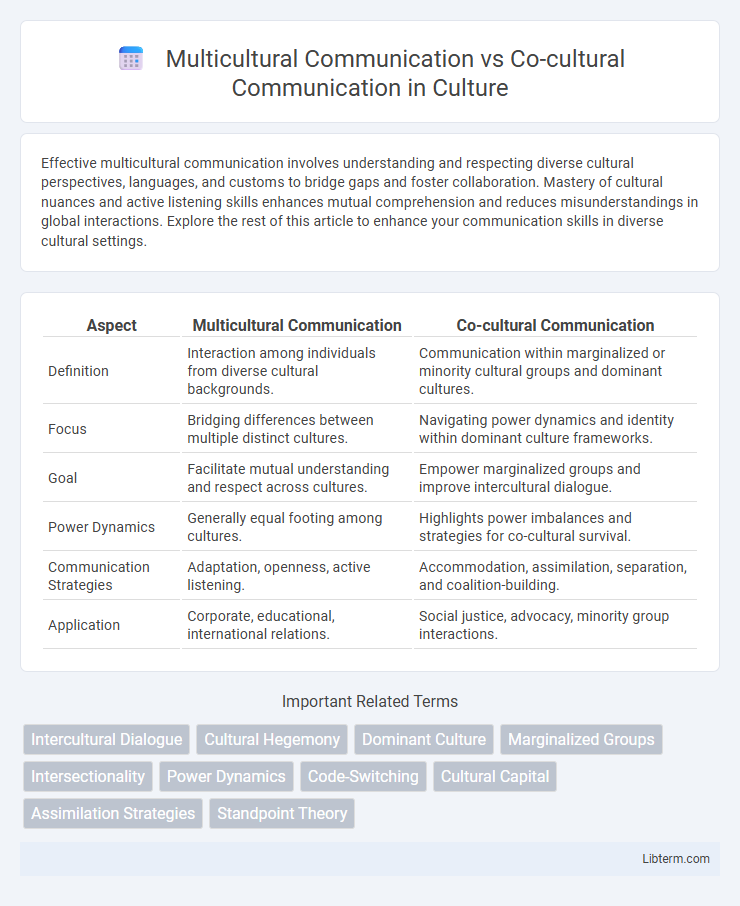Effective multicultural communication involves understanding and respecting diverse cultural perspectives, languages, and customs to bridge gaps and foster collaboration. Mastery of cultural nuances and active listening skills enhances mutual comprehension and reduces misunderstandings in global interactions. Explore the rest of this article to enhance your communication skills in diverse cultural settings.
Table of Comparison
| Aspect | Multicultural Communication | Co-cultural Communication |
|---|---|---|
| Definition | Interaction among individuals from diverse cultural backgrounds. | Communication within marginalized or minority cultural groups and dominant cultures. |
| Focus | Bridging differences between multiple distinct cultures. | Navigating power dynamics and identity within dominant culture frameworks. |
| Goal | Facilitate mutual understanding and respect across cultures. | Empower marginalized groups and improve intercultural dialogue. |
| Power Dynamics | Generally equal footing among cultures. | Highlights power imbalances and strategies for co-cultural survival. |
| Communication Strategies | Adaptation, openness, active listening. | Accommodation, assimilation, separation, and coalition-building. |
| Application | Corporate, educational, international relations. | Social justice, advocacy, minority group interactions. |
Understanding Multicultural Communication
Understanding multicultural communication involves recognizing and navigating the diverse cultural values, beliefs, and communication styles present across different societies. It requires sensitivity to language nuances, nonverbal cues, and context to foster effective interactions in global or diverse settings. Mastery of multicultural communication enhances collaboration and reduces misunderstandings in international business, education, and social environments.
Defining Co-cultural Communication
Co-cultural communication refers to the interactions between individuals from minority groups and the dominant societal group, emphasizing the unique experiences and perspectives within marginalized communities. It highlights how members of co-cultures negotiate identity, power dynamics, and communication styles to navigate social structures. This concept distinguishes itself from multicultural communication by focusing specifically on power differentials and the lived realities of subcultural groups.
Key Differences Between Multicultural and Co-cultural Communication
Multicultural communication involves interactions among people from distinctly different cultural backgrounds, emphasizing diverse national, ethnic, or racial identities, while co-cultural communication focuses on groups within a dominant culture that share unique identities, such as gender, sexual orientation, or socioeconomic status. Multicultural communication often addresses broader, macro-level societal differences, whereas co-cultural communication highlights micro-level dynamics related to power, marginalization, and identity negotiation within a dominant culture. Effective understanding of these distinctions enhances cross-group dialogue by recognizing both large-scale cultural diversity and the nuanced experiences of co-cultural group members.
Historical Backgrounds of Both Concepts
Multicultural communication emerged from social science research in the mid-20th century, addressing interactions between distinct cultural groups, primarily emphasizing ethnicity and nationality. Co-cultural communication developed later, rooted in the work of Mark Orbe in the 1990s, focusing on marginalized groups within dominant societal structures and how these groups communicate to negotiate power dynamics. Both concepts reflect evolving understandings of identity, power, and social context in communication studies.
The Role of Power Dynamics
Power dynamics play a crucial role in distinguishing multicultural communication from co-cultural communication. Multicultural communication involves interactions among diverse cultural groups where power imbalances may shape dialogue and influence representation. Co-cultural communication specifically addresses how marginalized or non-dominant groups navigate communication within a dominant culture, highlighting strategies to manage power relations and assert identity.
Challenges in Multicultural Communication
Challenges in multicultural communication often stem from language barriers, differing cultural norms, and varying communication styles that can lead to misunderstandings. Misinterpretation of nonverbal cues and ethnocentrism further complicate interactions between individuals from diverse cultural backgrounds. Effective multicultural communication requires heightened cultural awareness, adaptability, and active listening skills to bridge these gaps.
Barriers in Co-cultural Communication
Barriers in co-cultural communication often arise from power imbalances, where dominant groups marginalize or silence minority voices, leading to misunderstandings and reduced participation. Language differences, stereotypes, and lack of cultural awareness further hinder effective interaction within co-cultural contexts. Overcoming these barriers requires active listening, cultural sensitivity, and strategies to empower co-cultural group members in expressing their identities and perspectives.
Practical Examples in Workplace Settings
Multicultural communication involves interactions among individuals from diverse cultural backgrounds, such as when a global team collaborates on a project, requiring awareness of language differences and varying social norms. Co-cultural communication occurs within a dominant culture where marginalized groups negotiate identity and communication styles, exemplified by an employee from a minority group adapting communication to fit mainstream corporate culture while preserving their unique perspective. Practical workplace examples include managing cross-cultural conflicts in multicultural teams and creating inclusive policies that respect co-cultural identities to enhance collaboration and productivity.
Strategies for Effective Intercultural Interaction
Multicultural communication involves engaging with multiple cultural groups, emphasizing awareness of diverse cultural norms, values, and communication styles to avoid misunderstandings. Co-cultural communication focuses on interaction between dominant and non-dominant groups, requiring strategies such as flexible code-switching, active listening, and empathy to navigate power dynamics effectively. Practicing cultural humility, adapting messages to audience cultural contexts, and employing conflict resolution techniques enhance clarity and build trust in intercultural interactions.
Implications for Global Society
Multicultural communication involves interactions among people from different cultural backgrounds, emphasizing the need for understanding diverse cultural norms, values, and communication styles to foster effective global collaboration. Co-cultural communication focuses on the experiences and communication strategies of marginalized or minority groups within a dominant culture, highlighting the importance of recognizing power dynamics and social inclusion. These frameworks shape global society by promoting cultural sensitivity, reducing misunderstandings, and encouraging equitable dialogue in increasingly interconnected environments.
Multicultural Communication Infographic

 libterm.com
libterm.com